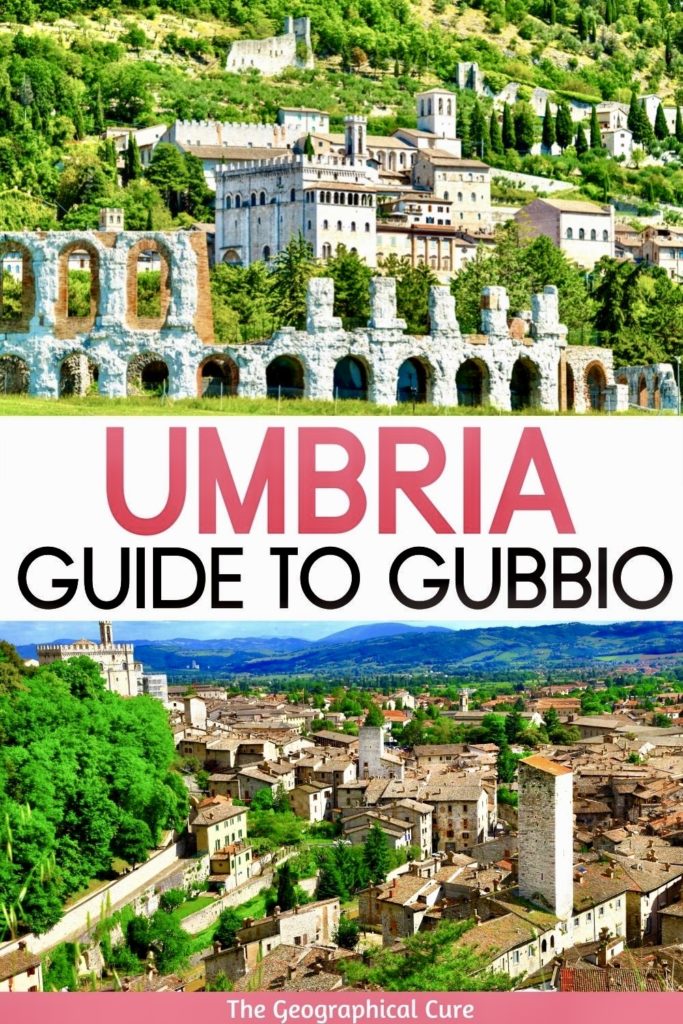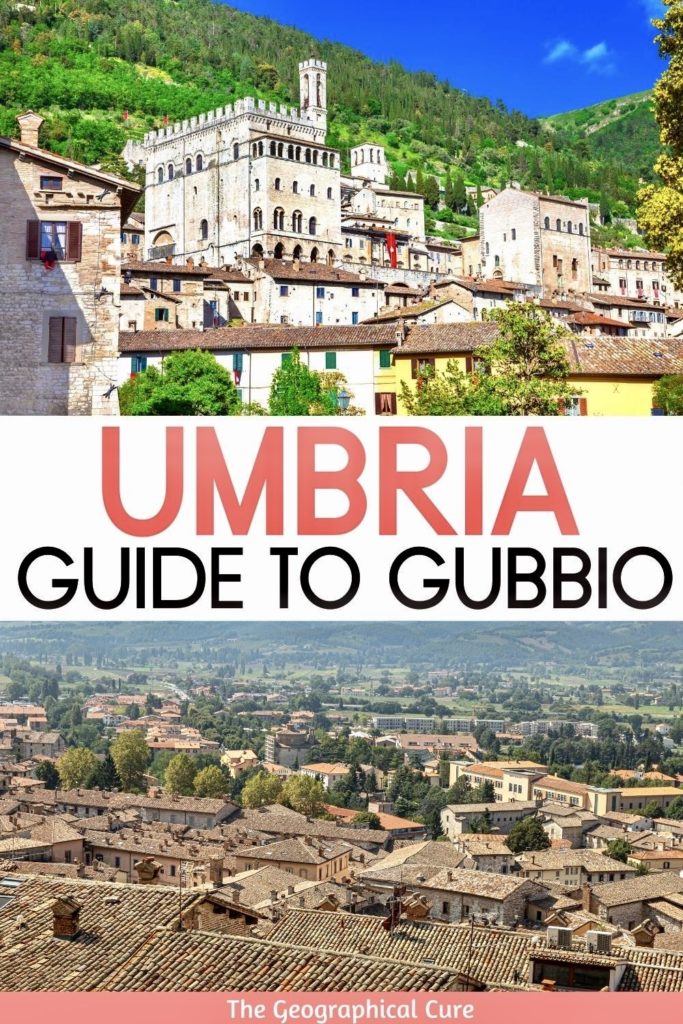Located in northeast Umbria, Gubbio is carved into the rugged slopes of Mount Inginoa. It’s a stunning town with a uniquely well-preserved medieval atmosphere.
Its historic charm is unrivaled, making it a popular destination for travelers seeking an off-the-beaten-path experience in Italy.
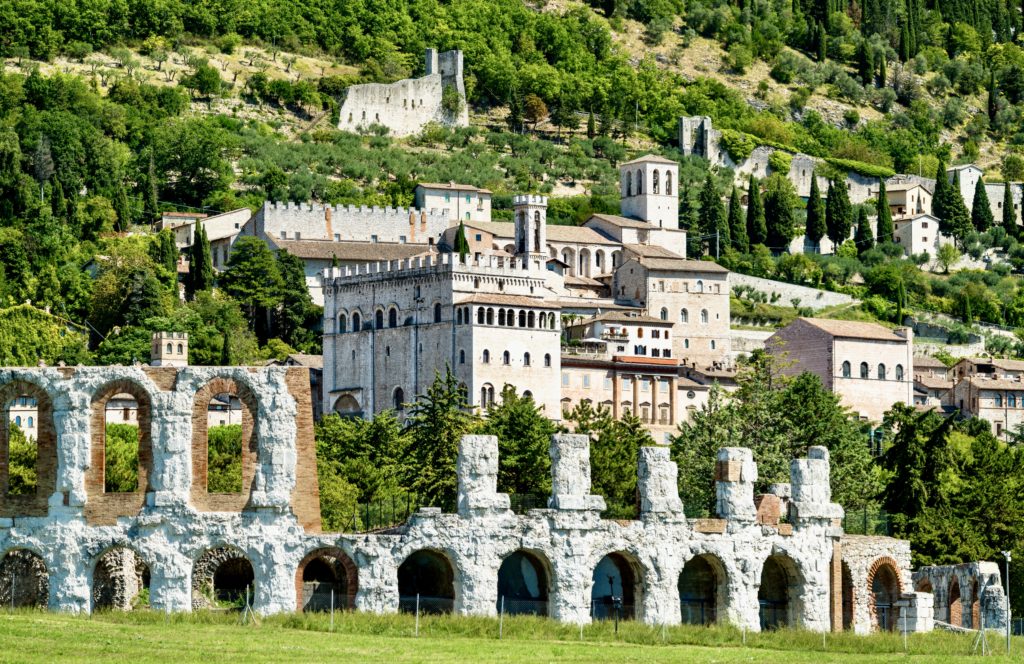
Gubbio is a spectacular vision of monumental buildings. The stony town seems trapped in the Middle Ages, with block after block of pinky-beige Romanesque and Gothic architecture.
Gubbio is famous for its Roman ruins, beautiful Piazza Grande, and the thrill-inducing funicular ride up to the Basilica of Saint Ubaldo.
In this guide, I cover all the top attractions and best things to do in Gubbio.
Short History Of Gubbio
Gubbio is a truly ancient city. The Etruscans founded the town in the 3rd century B.C. and named it Tota Ikuvina.
In the 1st century B.C., the Romans arrived and took over. Gubbio became the Roman town of Iguvium. Legend holds that Gubbio was used as a depository for Rome’s lunatics.
Insane or not, Gubbio prospered under Roman rule. There was a lot of construction, including the building of a Roman theater, the ruins of which can be seen today.
In 552, Gubbio was attacked and destroyed by the Goths. For the next few centuries, Gubbio was successively ruled by the Goths, the Byzantines, and the Longobards.
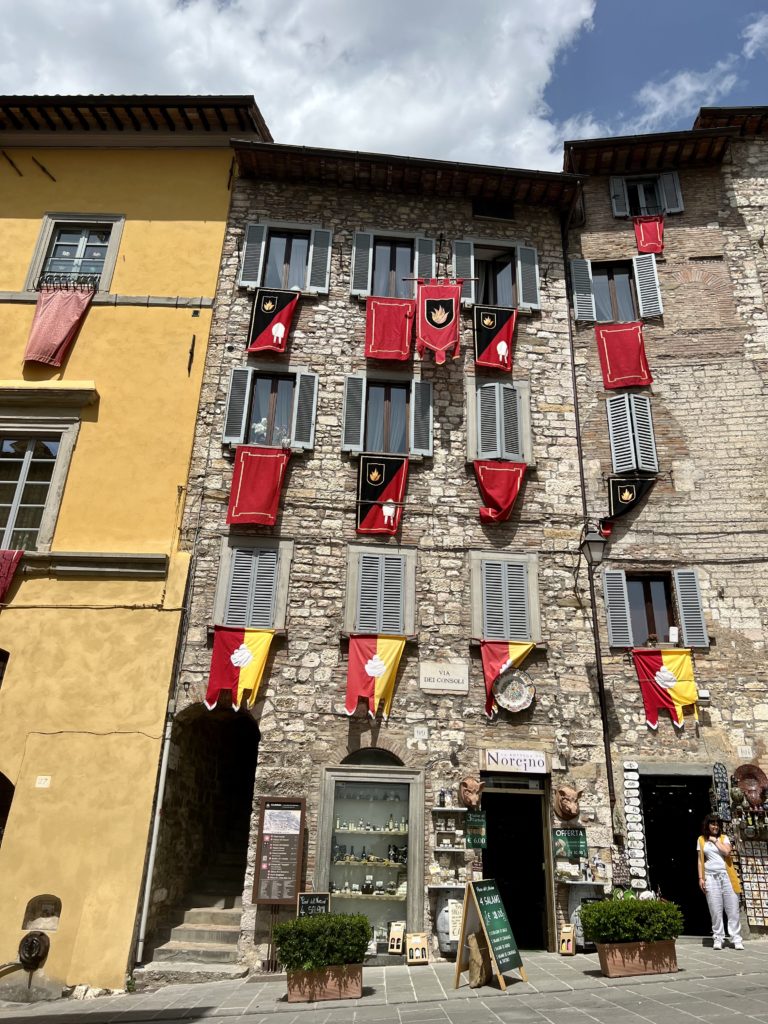
In the 1150s, Frederick Barbarossa, the holy Roman Emperor, led an attack on Gubbio. But the city was saved by Ubaldo of Gubbio, the town’s medieval bishop. He negotiated a peace treaty and kept Gubbio’s independence.
As with other cities in Umbria, there was continuous conflict between the civic government and the ambitious nobles throughout the Middle Ages.
From 1387 to 1508, the Dukes of Montefeltro ruled Gubbio from Urbino. They built a grand palace in the city.
Gubbio remained part of duchy until 1624, when it became part of the papal states. Gubbio remained a papal domain until the Unification of Italy in 1861.
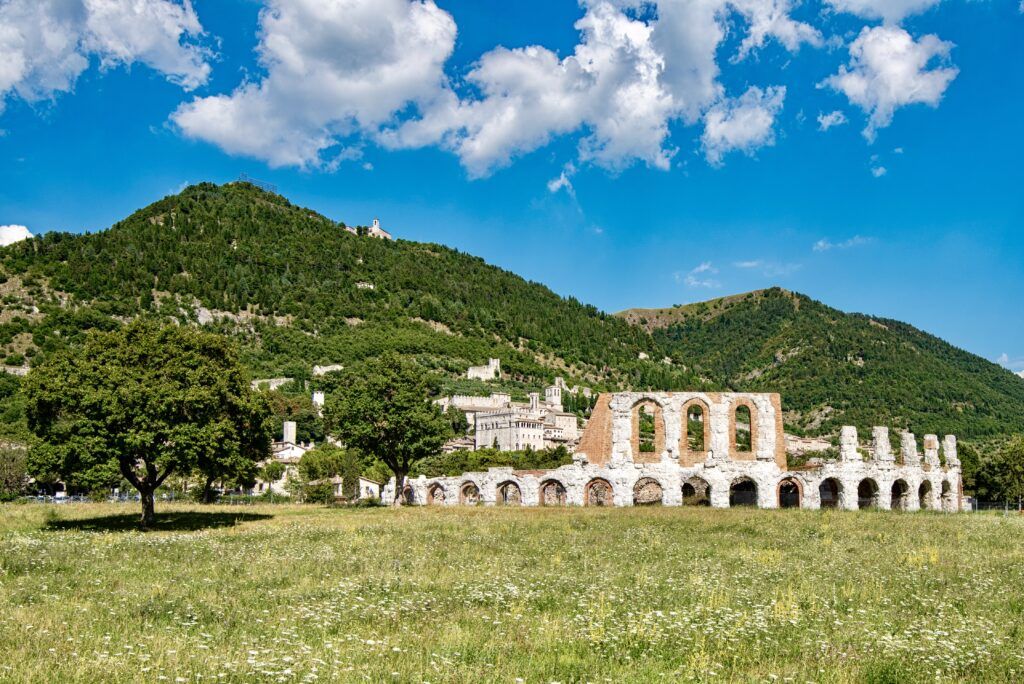
Top Attractions And Things To Do in Gubbio
1. Roman Theater
To the south of the city center are the ruins of a Roman theater. It’s definitely one of the best things to do and see in Gubbio.
There’s a large parking lot here. You can park there and visit the theater at the beginning or end of your visit to Gubbio.
The theater is one of the top attractions in Gubbio. It was built in the middle of 1st century B.C. It’s still used today as a concert or performance venue, seating almost 6,000 people.
The theater is the second largest surviving Roman theater in the world. It was built with large blocks of limestone over two levels. Only one level can be seen today.
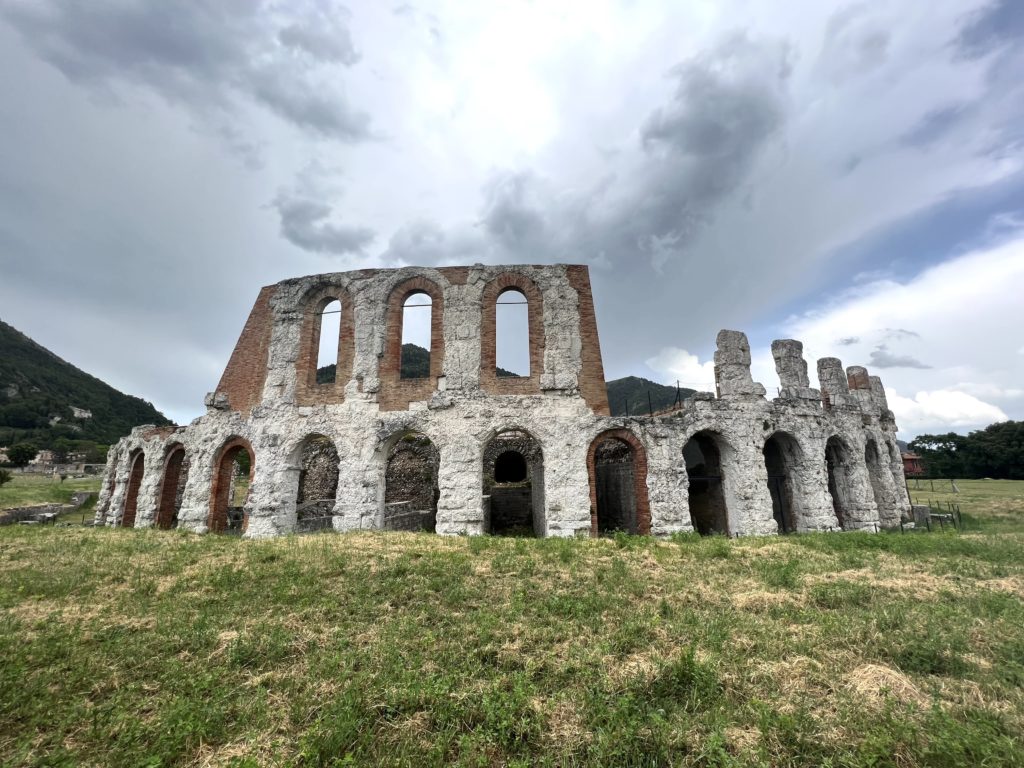
The steps were made of white limestone and the orchestra floor was paved with limestone plates.
The stage, now poorly preserved, once was decorated with columns with niches containing marble statues and frescos.
From inscriptions, we know that the theater even hosted gladiatorial games during the rule of Emperor Augustus.
You can visit the ruins for 3 euros. You’ll get a token to put in the turnstile for entry. There are also public restrooms around the corner from the ticket office.
Be sure to walk out onto the field. From there, you’ll have a great photo shot of Gubbio with the Roman Theater in the foreground.
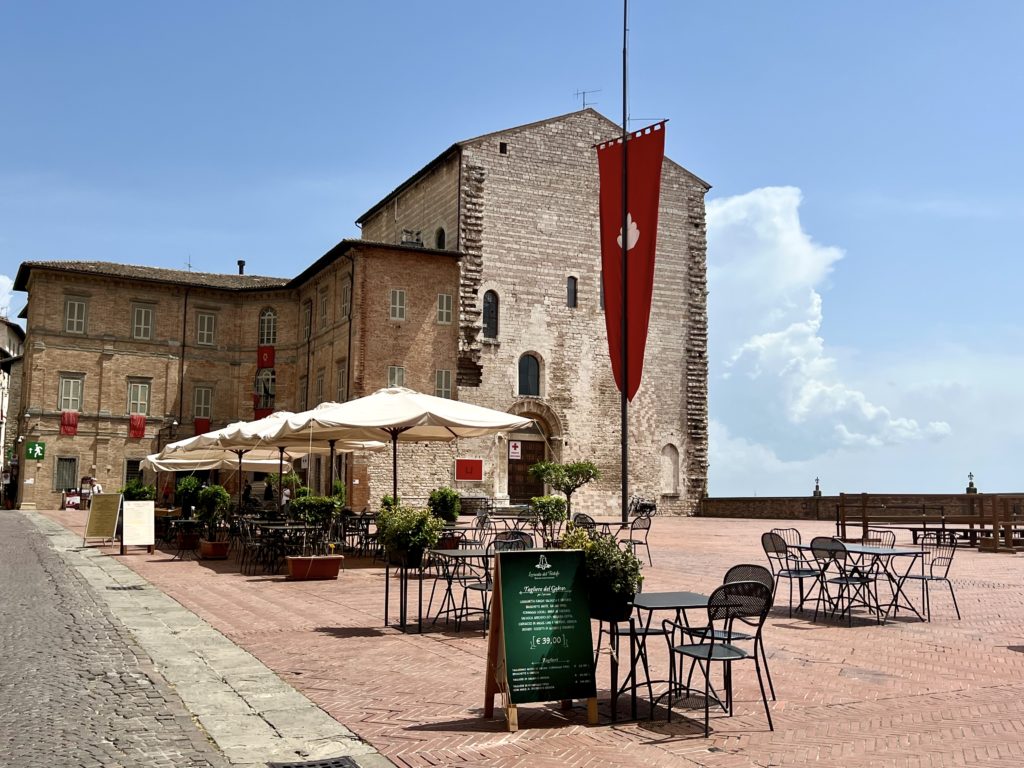
2. Piazza Grande
This “suspended square” was the result of an ambitious 14th century urban development plan. It was conceived as a monumental churchyard, connecting the Palazzo dei Consoli with the Palazzo del Podesta.
The result was Gubbio’s beautiful showpiece square.
On the south side of the piazza, you have a panoramic views over the lower town and valley beyond. You may feel like you’re hanging in space. On the other side, you’re ushered in to the Gubbio’s charming cobbled streets.
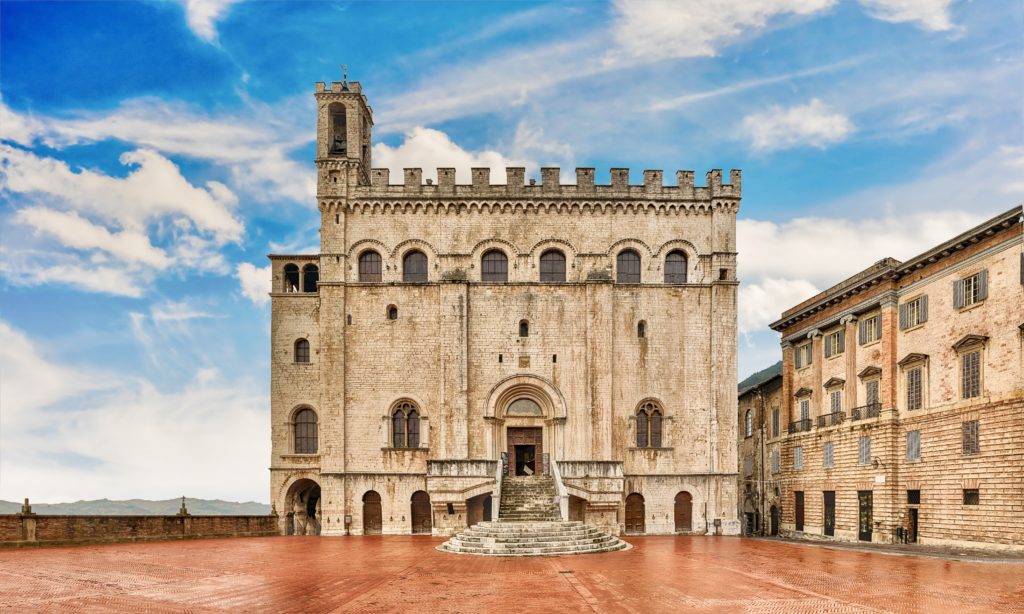
3. Palazzo dei Consoli
The 14th century Palace of the Consuls is a striking and well preserved medieval civic building designed by Angelo da Orvieto. It was where the parliament gathered in the Middle Ages.
The rusticated facade is offset by pilasters. The second tier is topped with crenellations. A slim tower rises from the left hand corner of the building. And a grand staircase leads up to the entrance.
The tower has a two ton bell. It isn’t rung with the usual ropes. Rather, it’s rung by men kicking a pedal.
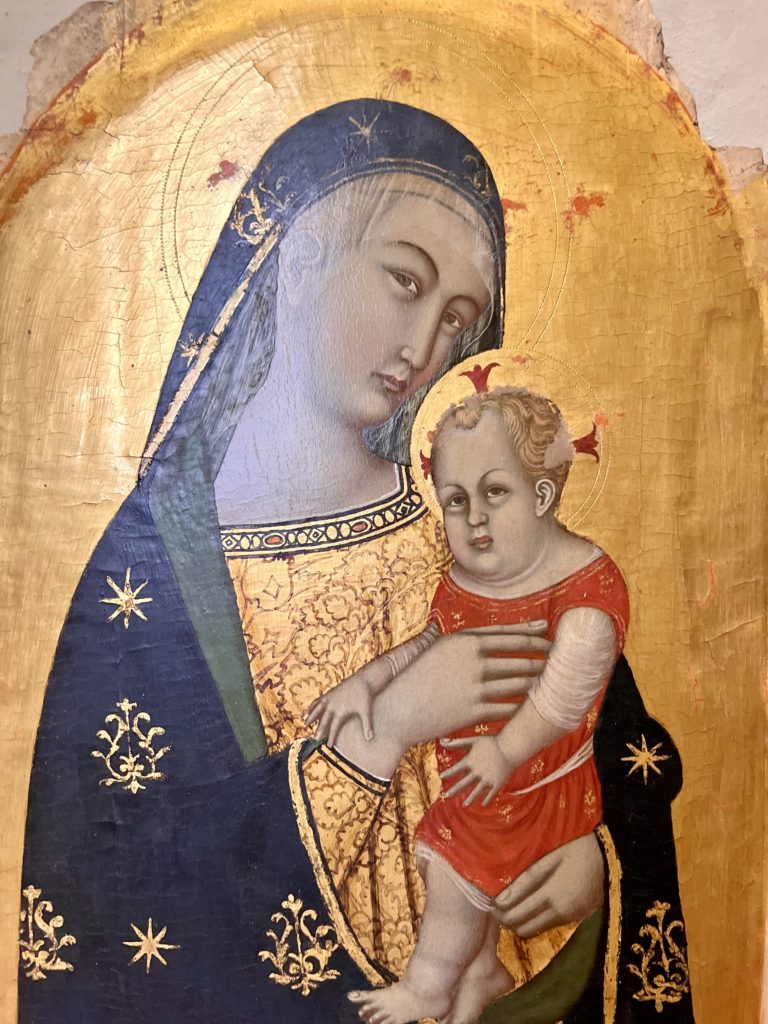
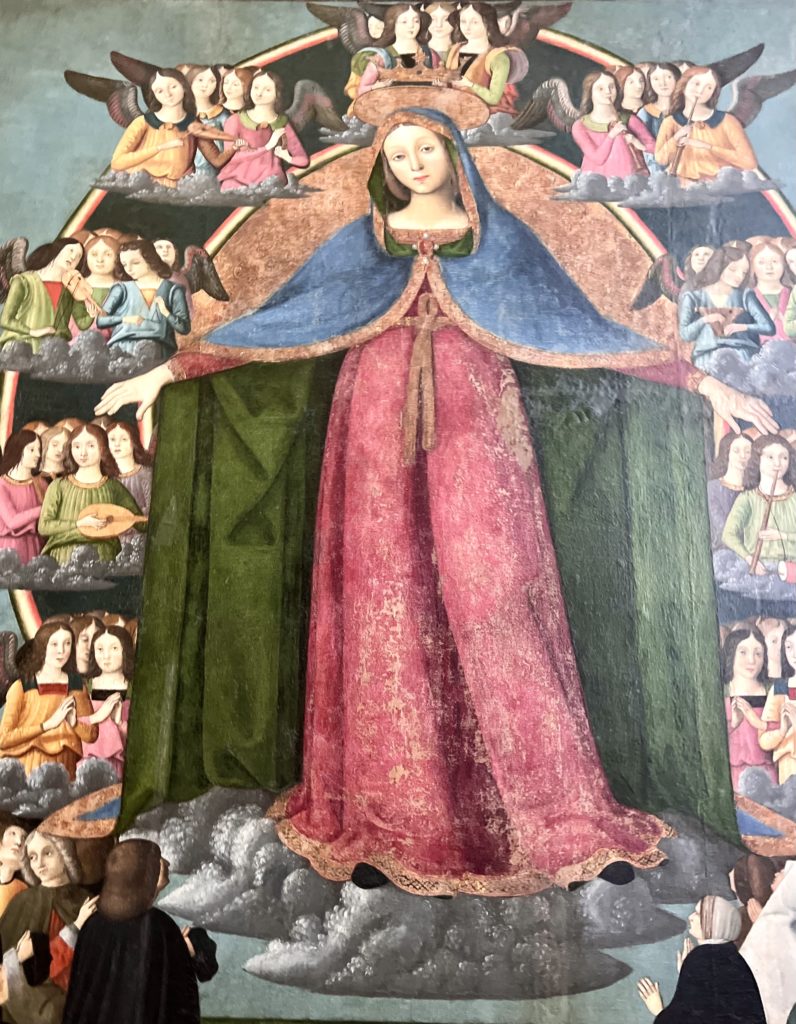
In the Middle Ages, the palace was the seat of the courts and the consuls who governed the city.
There were two consuls from each of the four districts of Gubbio. They only served for two months and could not leave the palace during their tenure to avoid outside influence.
Today the palace houses the town’s Civic Museum. The most significant piece from the collection are the ancient bronze Iguvine tablets. Discovered in 1444, the tablets date to the 2nd century B.C.
They are effectively Umbria’s Rosetta Stone. They are inscribed in Latin and an ancient Umbrian language.
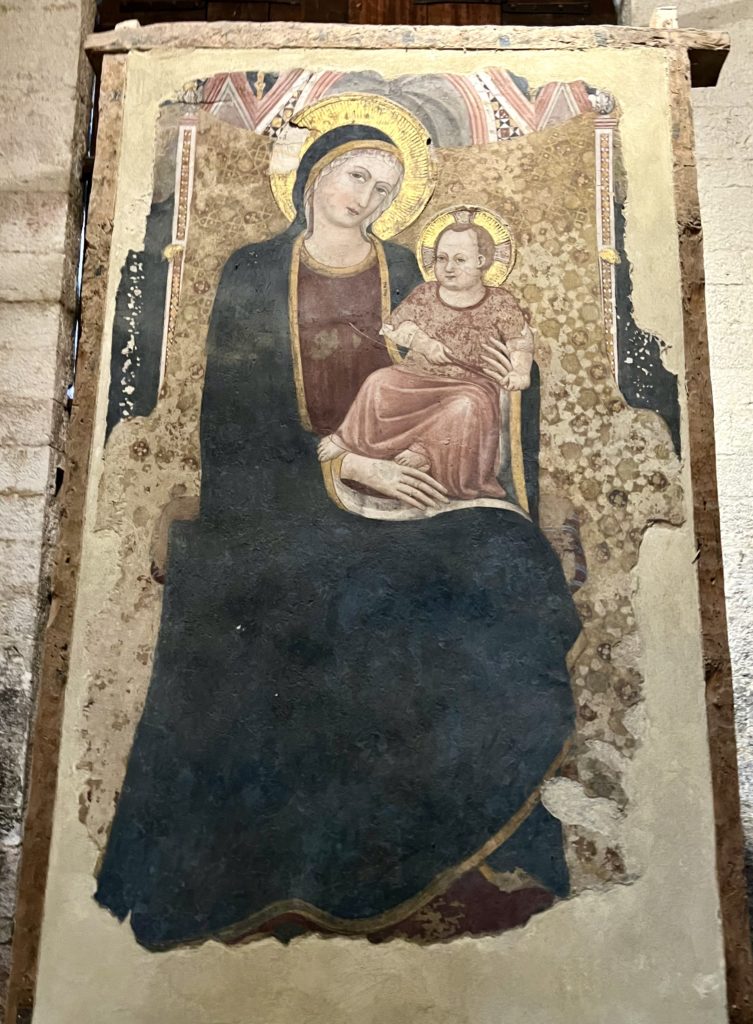
They tell the tale of ancient religious rituals in Gubbio. Just opposite the Iguvine Tablets is the Maestà dei Consoli (The Consuls’ Madonna in Majesty).
The museum also has a collection of ceramics and a pinacoteca where you can see paintings from the Medieval to Baroque eras.
Don’t forget to step out on the viewing terrace for lovely panoramic views.
The museum is open from 10:00 am to 6:00 pm. The ticket price is 7 euros.
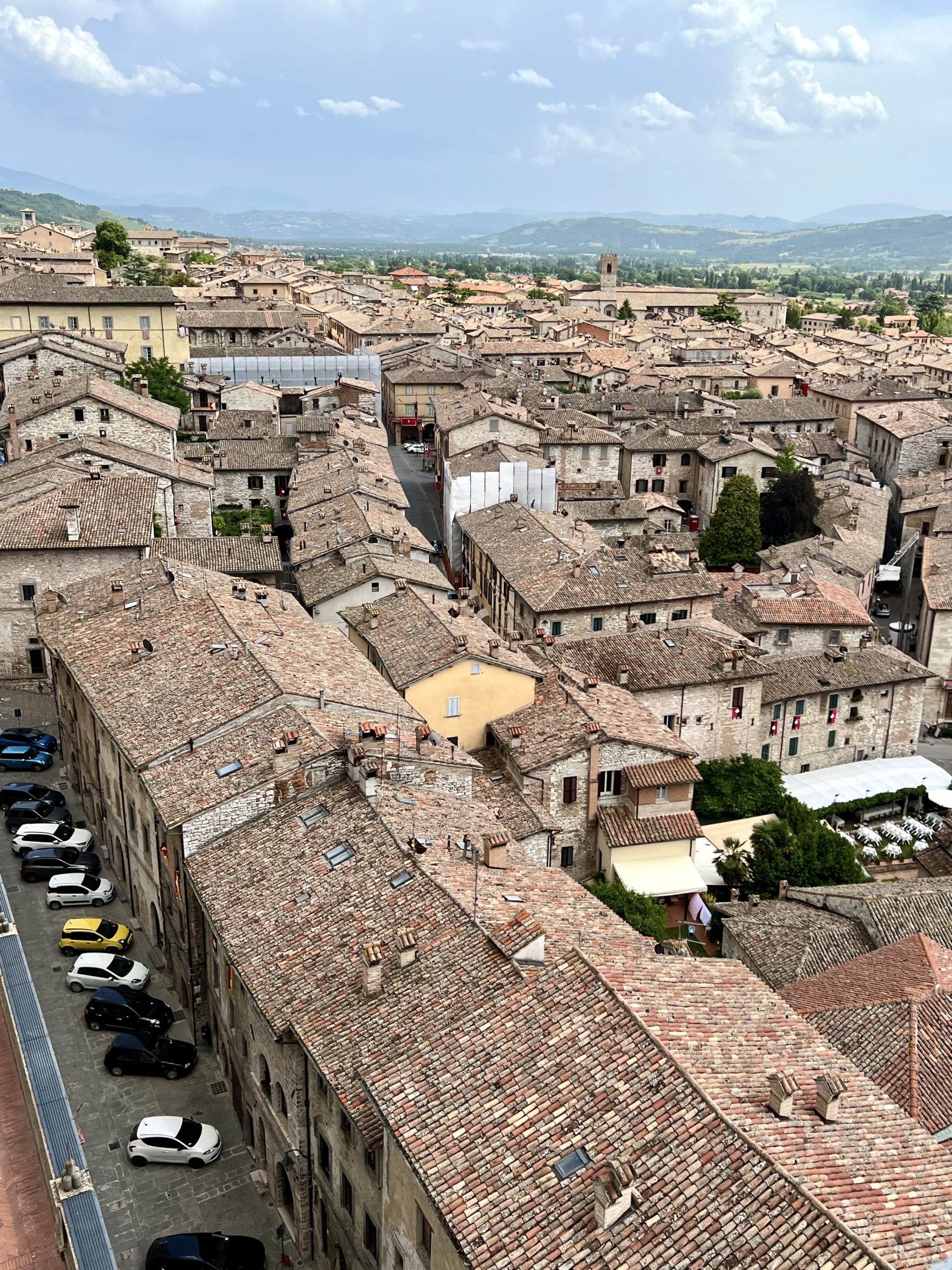
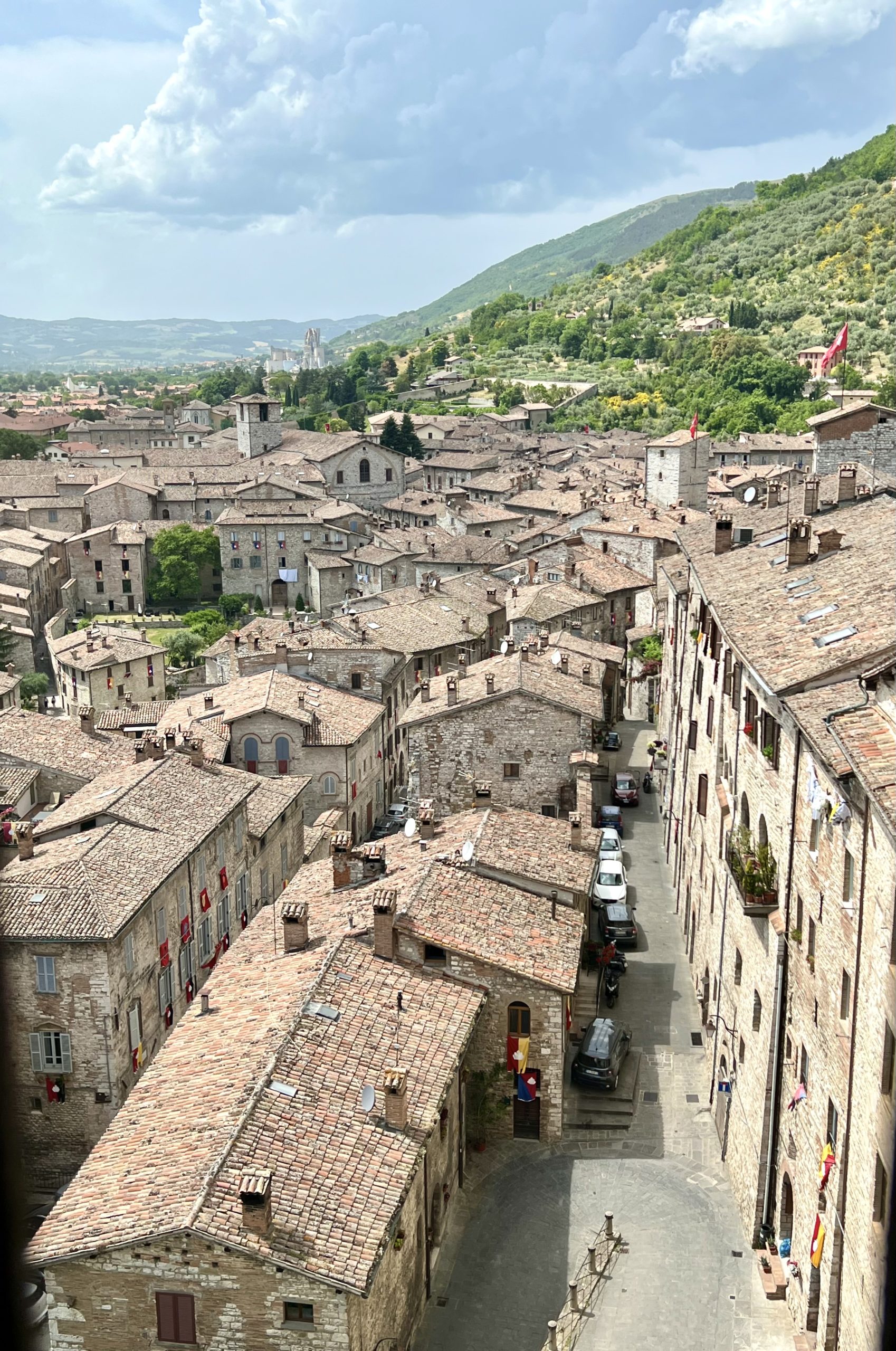
4. Diocesan Museum
The Diocesan Museum is housed in the Palazzo del Capitolo dei Canonici, an elegant Gothic structure next to the Duomo. Displays are arranged over three levels.
The collection includes Roman and Medieval sculpture that was formerly in Gubbio cathedral and paintings from the 12th to 17th centuries.
On the ground floor is a massive 16th century wine barrel. The rare piece has a capacity of over 20,000 liters.
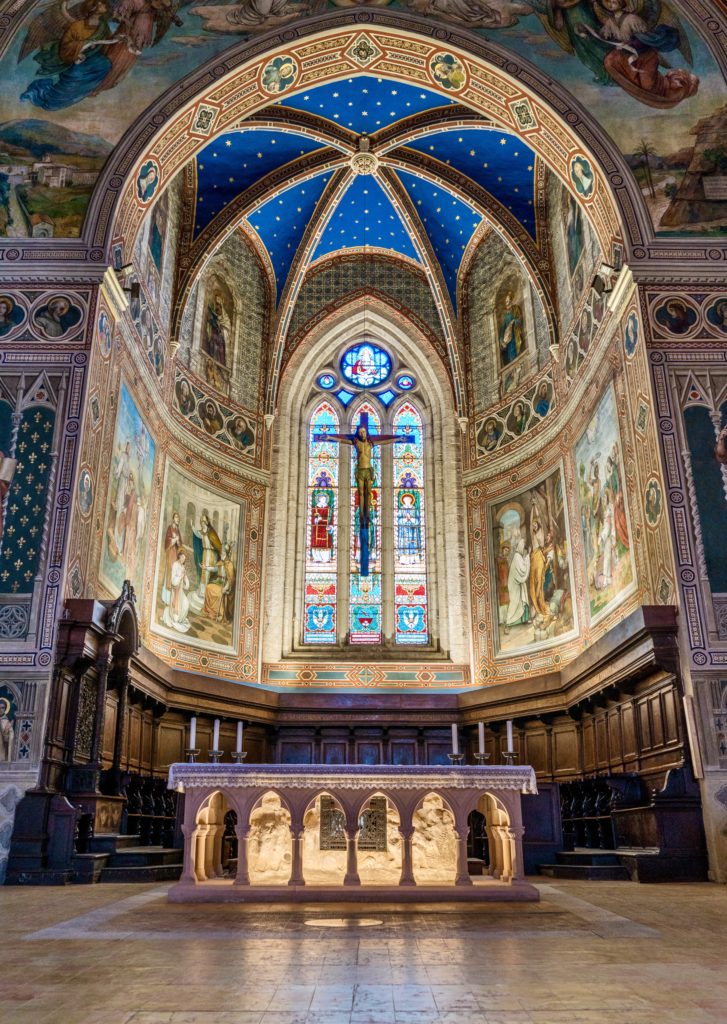
5. Gubbio Cathedral
Dating from the 13th century, Gubbio’s Duomo is dedicated to Saints Mariano and Giacomo. They were two martyrs whose bodies were brought to Gubbio in the 5th century.
The cathedral was built atop a Romanesque church. It has a simple brick facade and a rather dour interior.
It’s a rare duomo without a piazza in front. This makes it hard to take pictures of the facade.
Inside, a single nave is propped up by 10 arches. You’ll see paintings from the 14th to 16th centuries and some fresco fragments. The stained glass windows in the apse are from the 20th century.
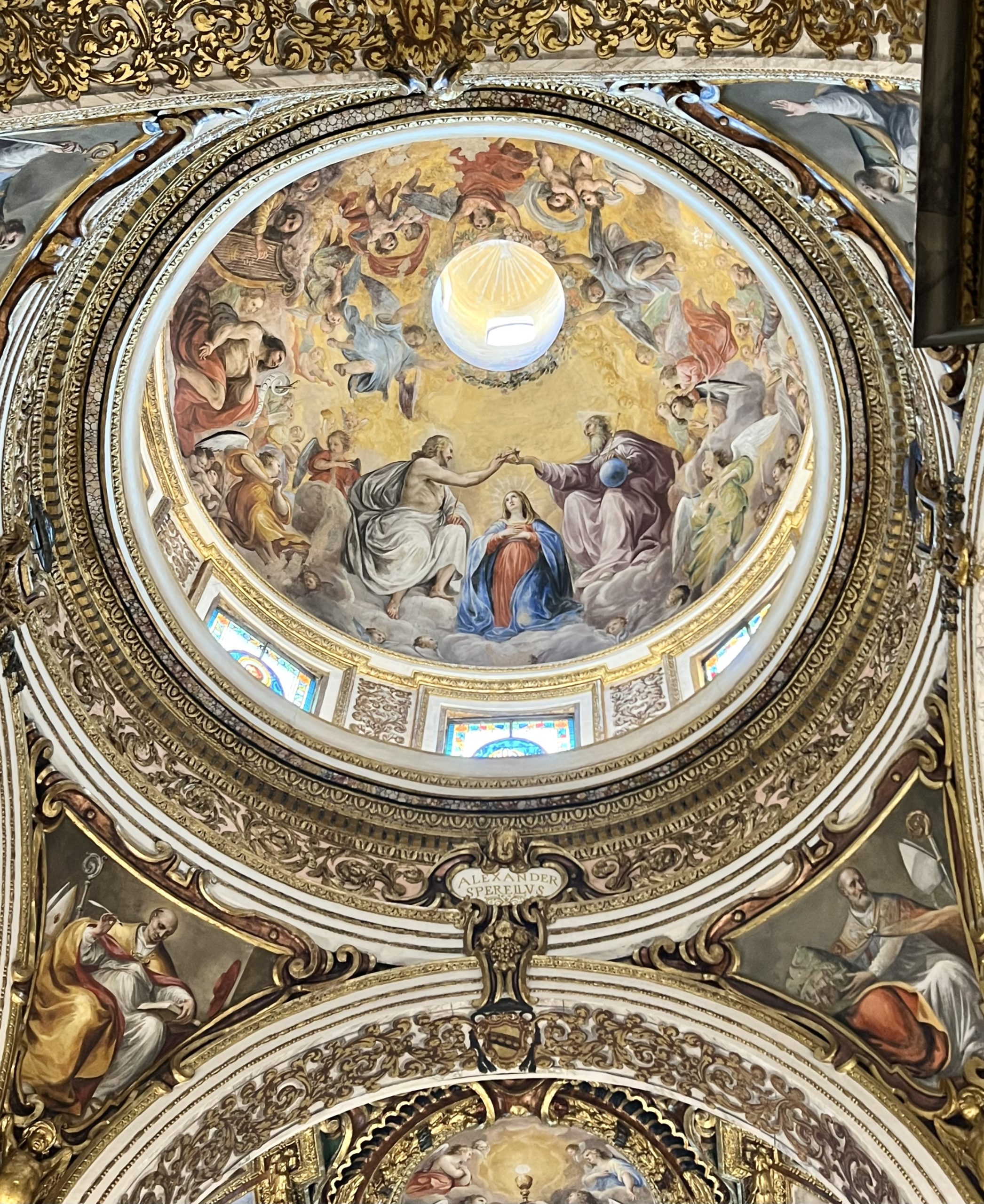
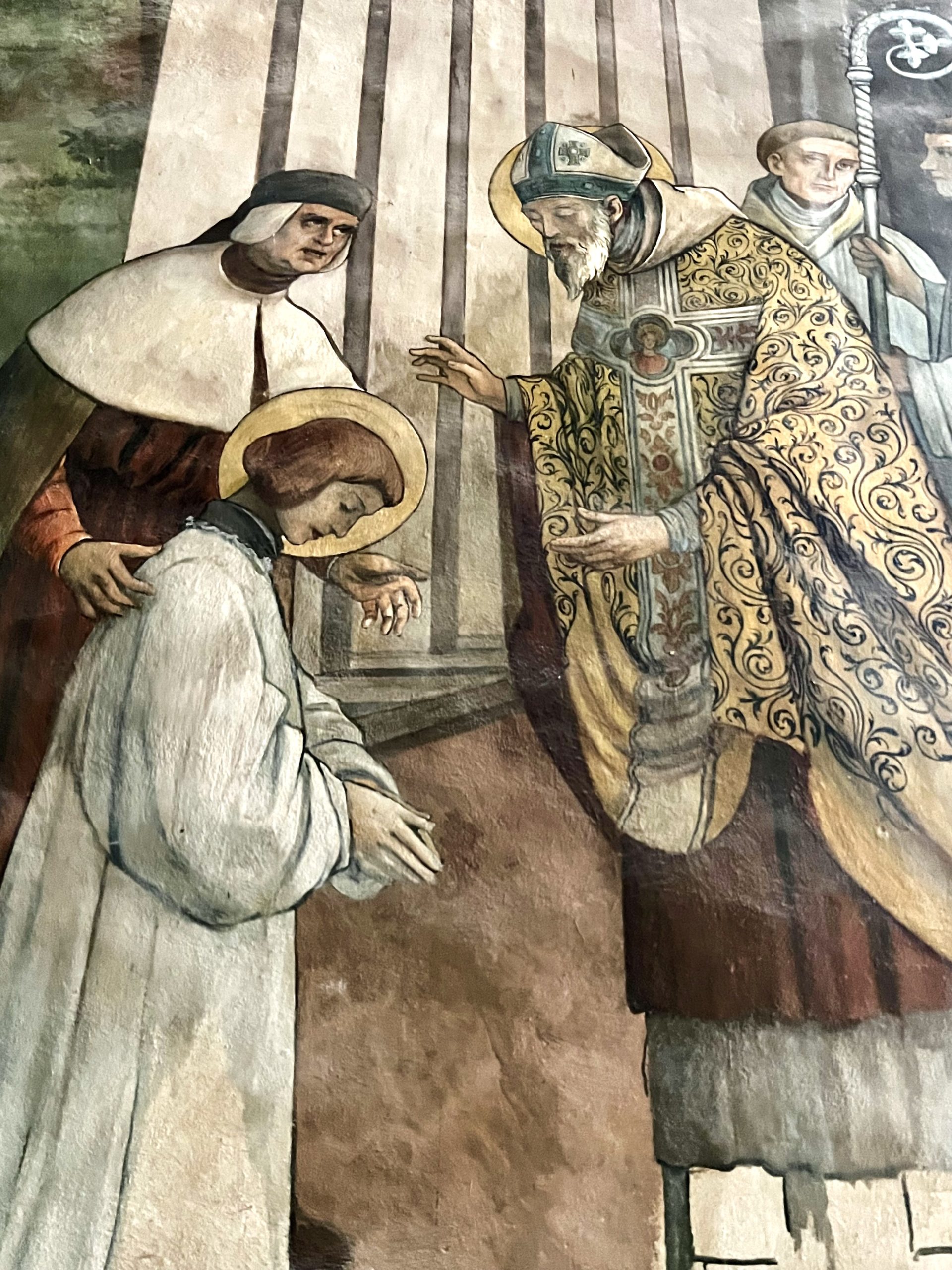
In the 18th century, the cathedral was “Baroquified.” The Chapel of the Holy Sacrament was added.
The cathedral is largely devoid of natural light. So you’ll need to pop in one euro coin to light up the chapel to see it properly.
The duomo also houses Gubbio’s most important relic, a finger of St. John the Baptist.
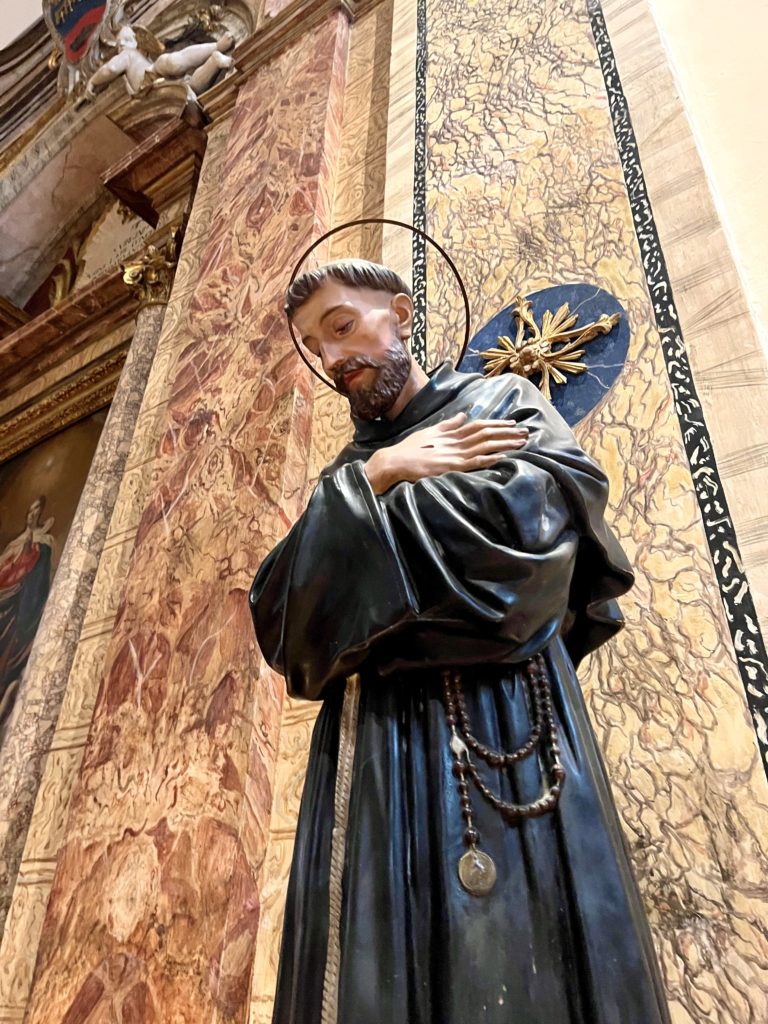
6. Basilica of St. Francis
This Gothic church dates to the 13th century and is the largest one in Gubbio. It was the first settlement of the Franciscan order in Gubbio. It was established after St. Francis himself visited the town.
Inside, a tall nave and spacious aisles lie under vaults from the 18th century that replaced the wooden beams. There are frescos from the 13th and 14th century in the apse.
In the Chapel of St. Francis, you’ll find some beautiful frescos by Ottaviano Nelli, a famed Gubbio painter. Dating from 1410, they depict Stories of the Virgin.
The frescos were covered over with plaster in the 18th century. They were only rediscovered in 1040 and restored to their former glory.
There’s also an elegant cloister with more frescos and mullioned windows.
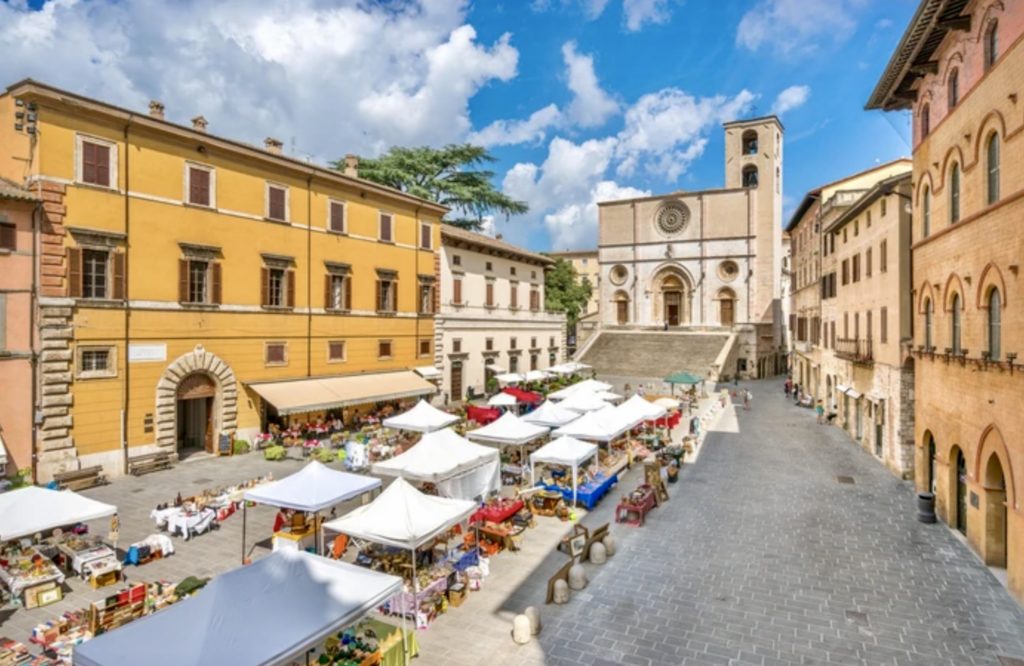
7. Church of St. John the Baptist
This church was built over Gubbio’s first cathedral. It’s mentioned in documents as far back as the 12th century.
It’s the only church in Gubbio with a baptismal font, and it’s quite exquisite.
The church has a Gothic facade, which was restored in the 20th century. Inside, there’s a single nave and four Gothic arches support the roof.
The walls are bright white. There are fresco fragments from the 14th and 15th century and plenty of paintings to admire.
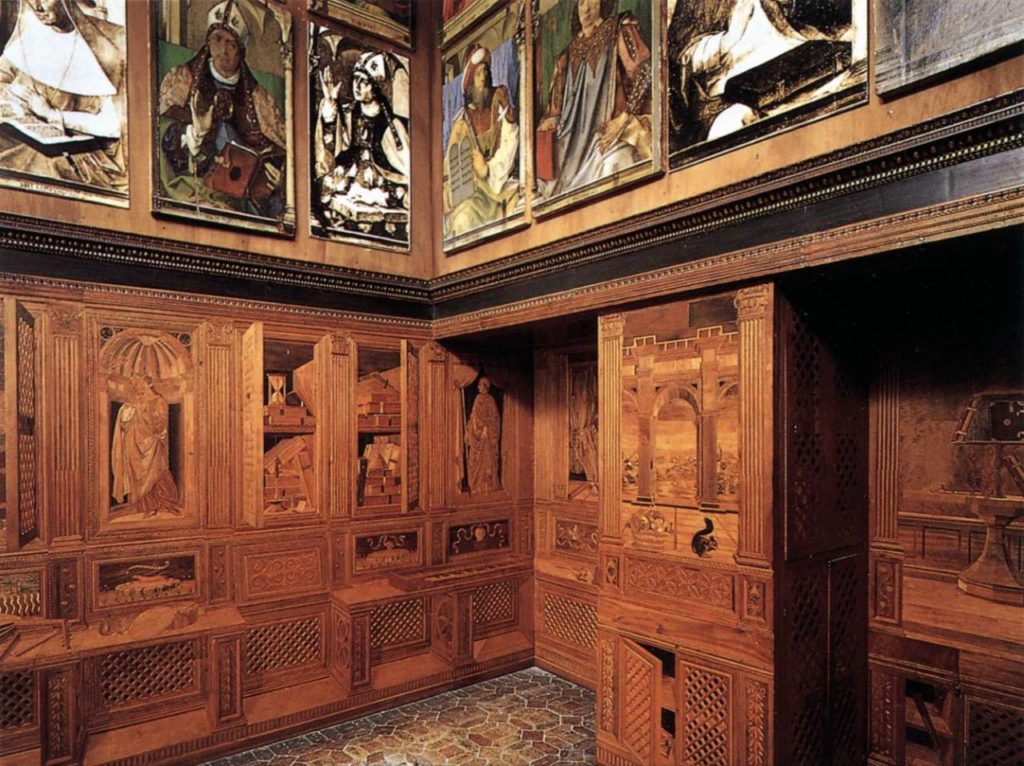
8. Ducal Palace
The Palazzo Ducal was built by Federico da Montefeltro, the Duke of Urbino, in 1480. It was the first example of Renaissance architecture in Gubbio.
It consists of two structures connected by an elegant courtyard, called the Courtyard of Honor. It’s a paragon of Renaissance principles and proportions.
Today, the palace houses a museum with a collection of paintings spanning the 13th to 18th centuries. There are multi-media presentations and a virtual library, where you can leaf through illuminated manuscripts.
You can also visit the Studiolo, the Duke’s Little Study. Such studios were all the rage among important noblemen in the 15th century Renaissance era.
The Studiolo was a personal retreat where Montefeltro could meditate and reflect. What you see is actually an exact replica of the original, which was sold to the Metropolitan Museum in New York City.
The wall space is entirely decorated with inlaid wood designs and a frieze of paintings. The cabinets display objects reflecting the duke’s artistic and scientific interests.
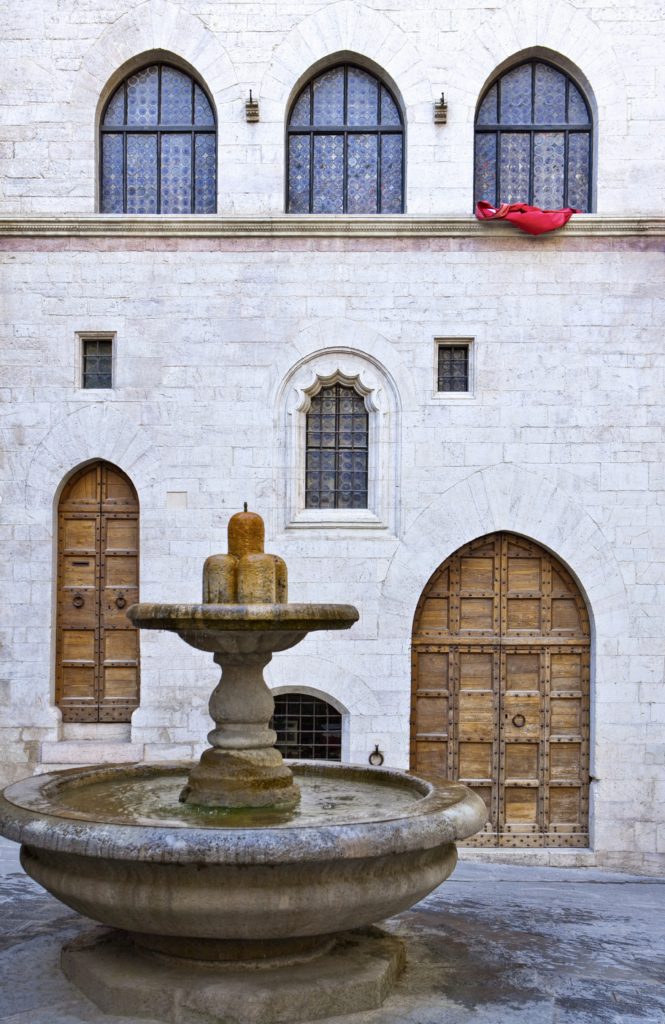
9. Fountain Of The Madman
Since Roman times, Gubbio has been known as a place of madness. The town has sired priests, mystics, and sorcerers who gave Gubbio its reputation.
Some say the town’s madness is due to the whole area being contaminated with iridium.
The Fontana dei Matti, or Fountain of the Madman, is in the Piazza del Bargello. Legend holds that if you take 3 laps around the fountain and are baptized with its water, you are officially a lunatic.
You don’t need an official baptism. Just splash yourself with water. Or dip your elbow in the fountain.
Then, you can pop into the souvenir shop in the Bargello Palace and get your patente di matto, or license to be crazy.
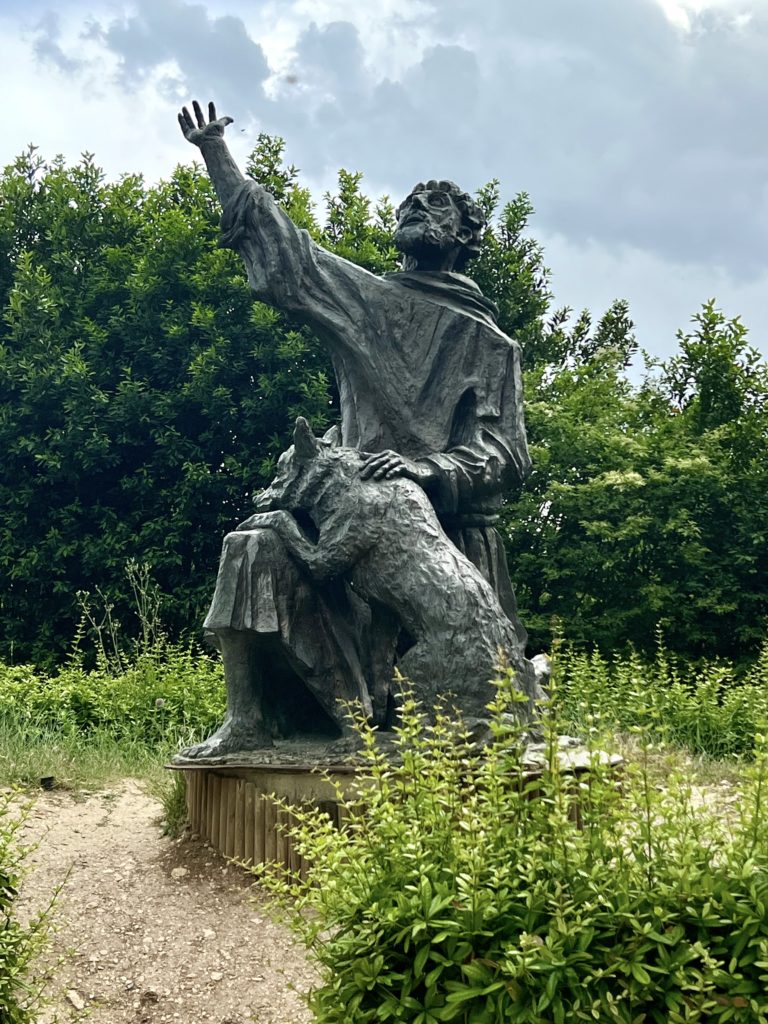
10. Wolf of Gubbio
The Wolf of Gubbio is one of the town’s most famous legends. When St. Francis was living in Gubbio around 1220, the town was being terrorized by a ferocious wolf. The townspeople huddled in their homes, refusing to leave the confines of the town.
Francis decided to go in search of the wolf. Not long after, he found a wolf bounding toward him with teeth bared.
Francis didn’t panic. He made the sign of the cross, spoke calmly, and blessed the wolf.
In what can only be described as a miracle, the wolf promptly stopped the attack and laid at Francis’ feet. Francis and the wolf made an oath. If the wolf stopped attacking the town, they would feed and care for him.
Both sides kept their part of the bargain and the wolf walked among humans till the end of his days.
A sculpture commemorating the legend is right outside the Basilica of St. Francis.
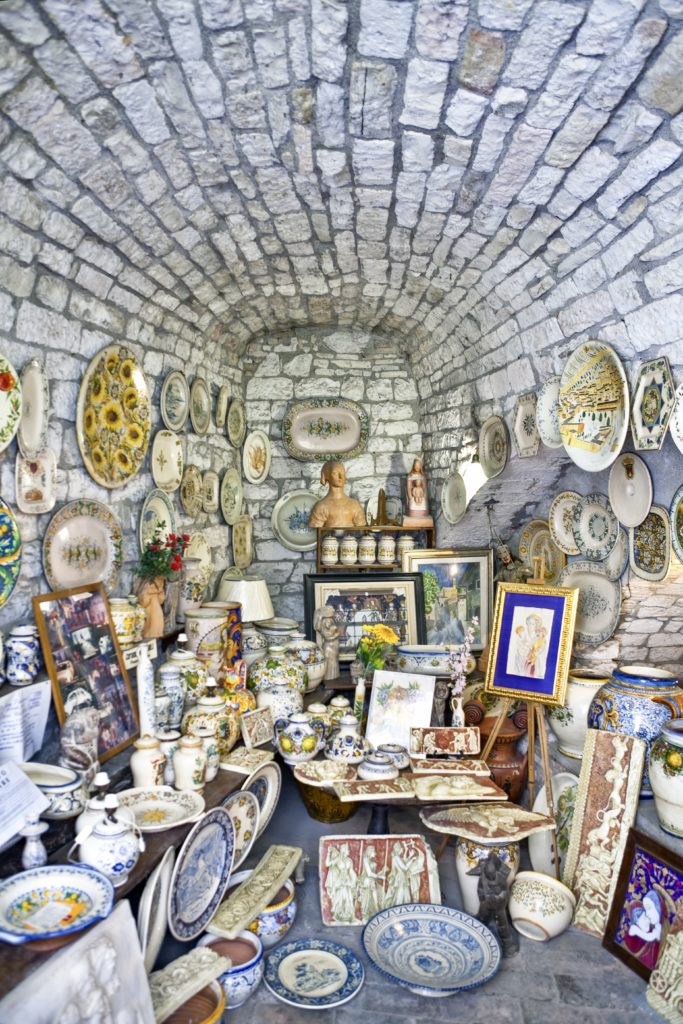
11. Shops in Gubbio
Gubbio is filled with quaint shops and quirky stalls. The main shopping streets are Corso Garibaldi and Via dei Consoli. You can find some beautifully made artisan products like ceramics, wood, leather, and wrought iron.
Gubbio is especially well known for its medieval and Renaissance ceramics. The designs are elaborate and notable for the deep golds, reds, and blues. Antichita McRoss and Ceramiche Biagioli have some wonderful examples.
Gubbio is also full of food shops. You can find honey, a fruity green olive oil, cheese, and pasta.
If you’re a truffle lover, the go to place is Tartufi di Gubbio. You can pick up homemade pasta at Pasta Fresca.
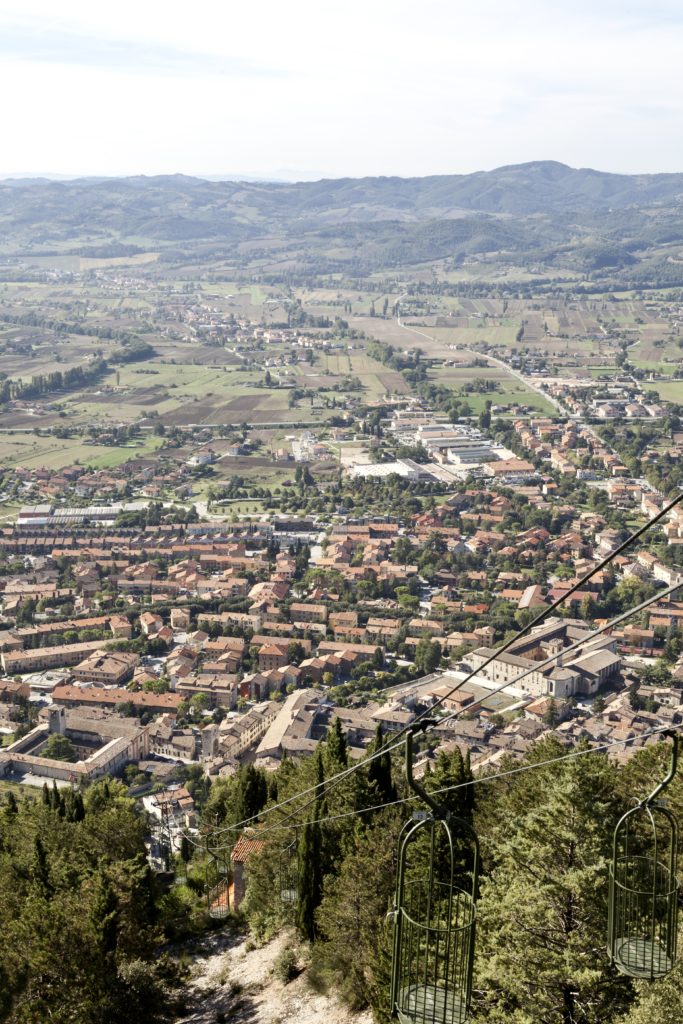
12. Funicular | Funiva Colle Eletto
It’s time to take to the skies. To get to the top of Mount Ingino, you should hop on the funicular. It was installed in 1960 and is one of the best and most fun things to do in Gubbio.
You’ll be whisked up the hill in an iron bird cage that holds two people. The top half isn’t enclosed. If you have fear of heights, you might want to pass.
Like a ski lift, the cages don’t stop. You have to hop in (with some help form the operator) and hop off.
You can also hike up to the top. It’s about a 45 minute hike and you need good walking shoes. There are beautiful views of the town and the valley.
There are water fountains on the way. There are also signs that warn you about snakes. Once at the top, you can see for miles.
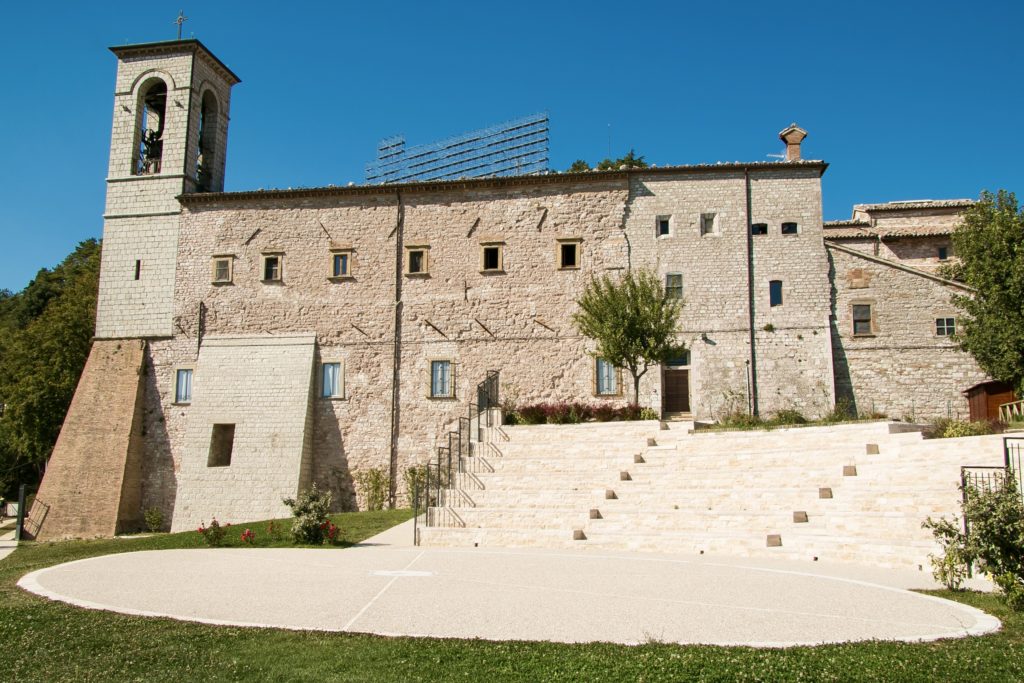
13. Basilica of St. Ubaldo
Once unleashed from your cage, you can visit the Basilica of Sant’Ubaldo.
Ubaldo was the former bishop and patron saint of Gubbio. His mummified remains are displayed in a crystal coffin.
Ubaldo died in 1160 and was thereafter declared a saint. He was known for his patience and ability to perform miracles.
Ubaldo’s cult was promoted by the Lateran church in Rome. He even has a statue on the Bernini colonnade of St. Peter’s Basilica.
Ubaldo’s titular basilica has a nave and four aisles decorated with paintings from the 16th to 18th centuries.
There’s also a restaurant and bar at the top of the hill.
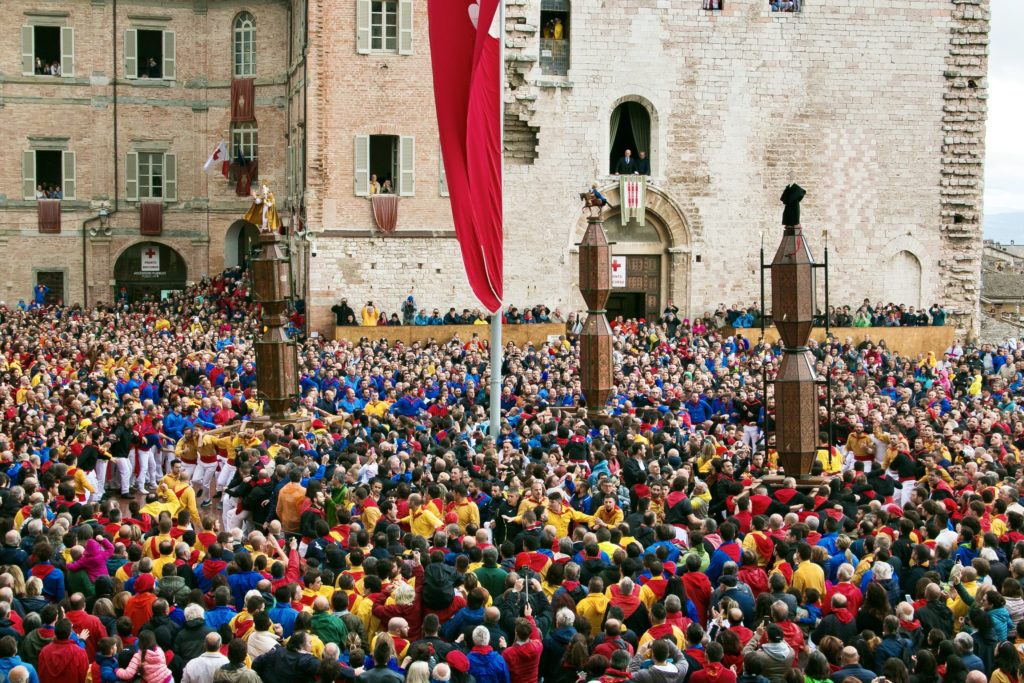
14. Race Of The Candles
The Race of the Candles is Gubbio’s famous festival-competition held on May 15 each year, on the eve of St. Ubaldo’s death. Dating from 1160, the competition embodies the town’s reputation for madness.
It combines themes of religion folklore, and pageantry. But in reality it’s a big street party.
The neighborhoods compete in the race under the colors of yellow, blue, or black. Like the contrade of Siena, you are born into or choose your neighborhood allegiance.
Three teams, composed of 12 men, race at breakneck speed through winding lanes to the summit of Mount Ingino. Each team carries a massive 600+ pound wooden candle through a 2.5 mile course.
According to legend, the task is so difficult that it can only be accomplished by pushing through mental barriers. The race takes place amid a cacophony of drums, horns, and church bells. Spectators are dressed in medieval costumes.
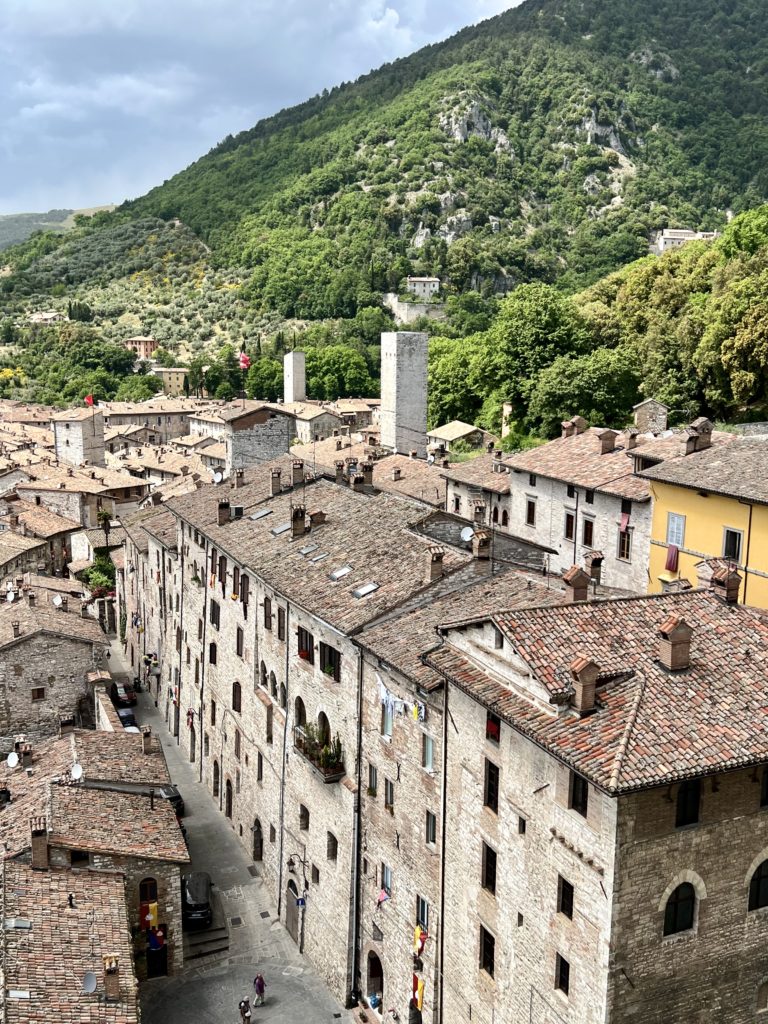
Tips For Visiting Gubbio
1. How To Get To Gubbio
It’s easiest to drive to Gubbio. The town is about 45 minutes from Perugia to the south, 45 minutes from Assisi to the south, or 1:50 from Sienna to the west.
As you approach the city, there’s a large parking next to the ruins of the Roman Theater. It’s easy and free to park there.
There’s no train station in Gubbio, so public transportation isn’t a good option. There is a train station 20 miles away in Perugia. From there, you can get a bus to Gubbio.
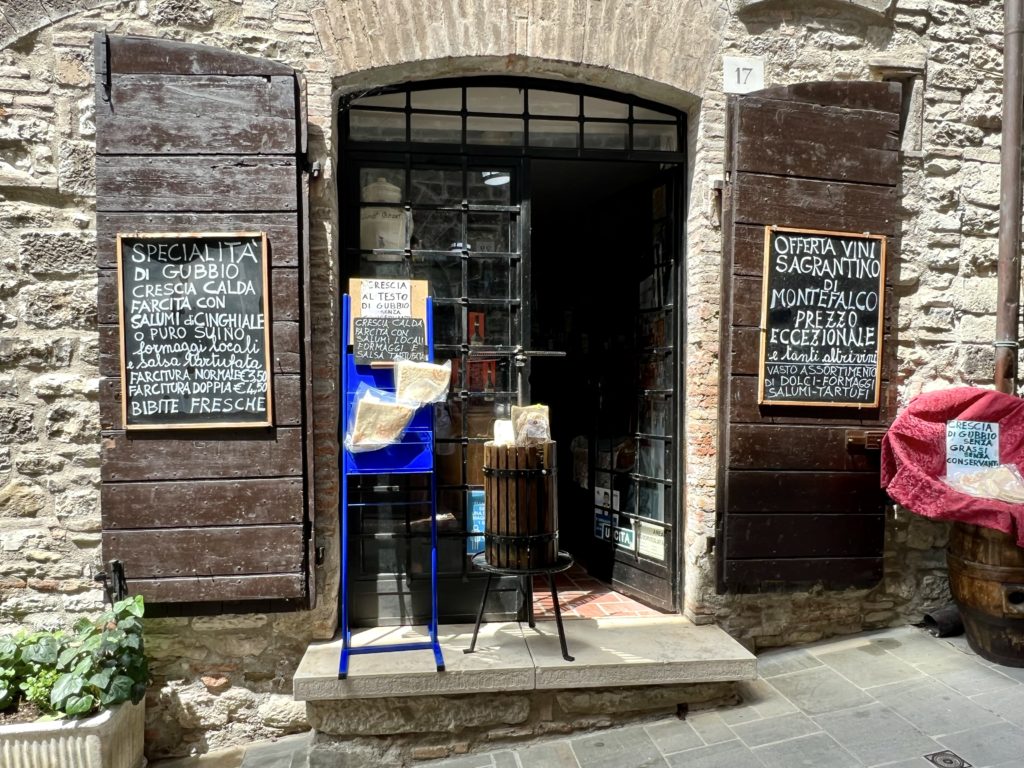
2. How To Get Around Gubbio
After parking, you need to hike up a seemingly vertical cobblestone path to reach the historic center.
You can walk everywhere in the town. But it’s almost completely vertical.
Because of this, there are elevators, with several stops, that take you up to the Duomo and the Ducal Palace. To get to the top of Mt. Ingino, you need to hop on the ski lift style funicular.
There’s also the Dotto Train. If you climb aboard, you’ll be zipped around on a 40 minute tour, which covers all the best things to do in Gubbio. Click here to book a ticket.
To help you get around, the town has installed numerous information placards and signs.
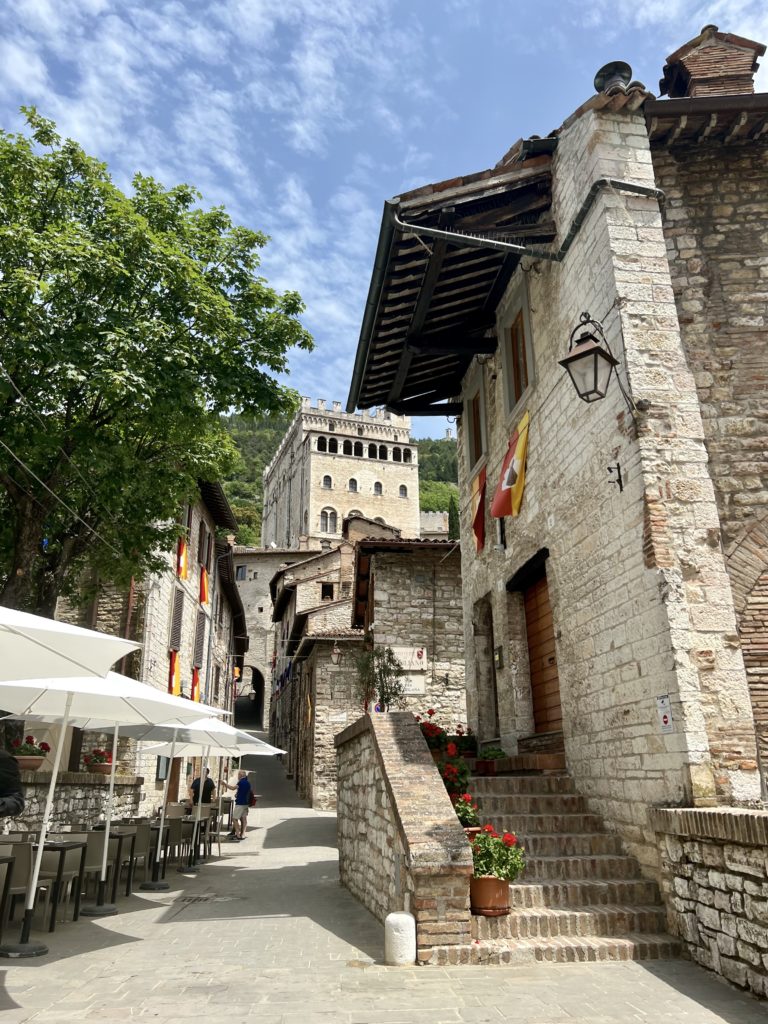
3. Guided Tours Of Gubbio
If you want the full scoop on Gubbio and its history and monuments, you may want to book a guided walking tour.
You can also book a guided street food tour. Or, take pasta making class or a pizza and tiramisu making class.
4. Where To Eat in Gubbio
I had an excellent lunch at Taverna del Lupo. I sat outside under the awning. But there’s also a beautiful interior with a vaulted stone ceiling.
Ristorante di Porta Tessenaca is also a good choice. It’s housed in a historic building on a quiet street. The subterranean dining room is the perfect place for a romantic meal.
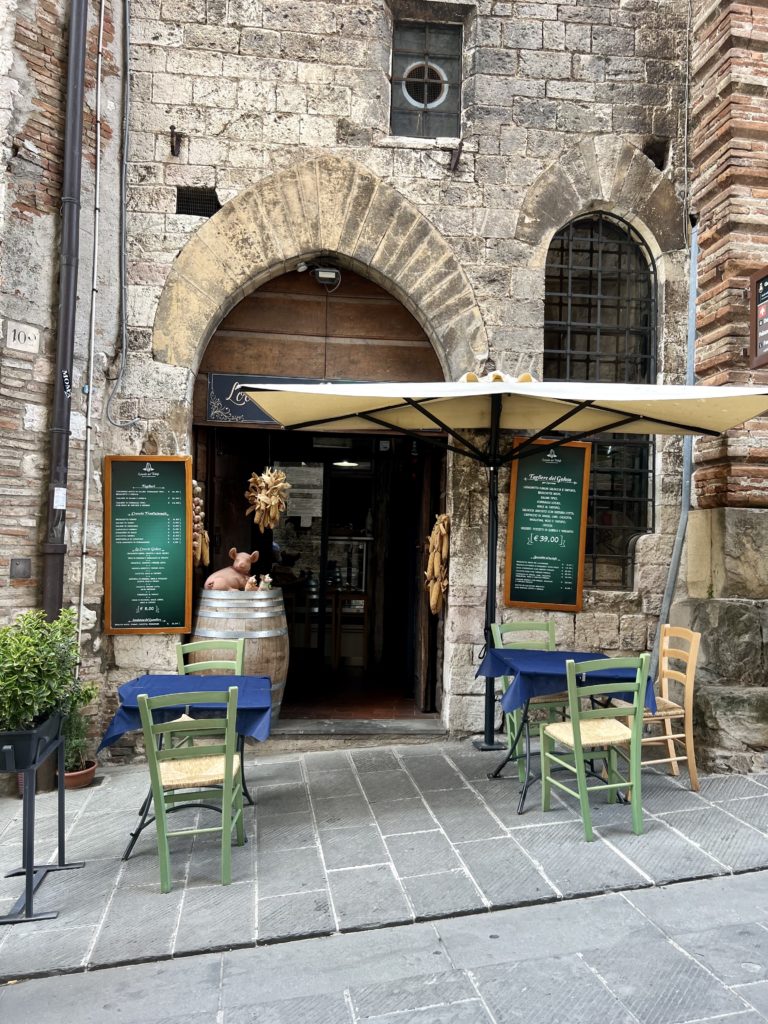
5. Where To Stay in Gubbio
A great place to stay in Gubbio is the Park Hotel ai Cappuccino. It’s a small luxury hotel that is just beyond the city walls.
The Palace Bosone Hotel is an upscale hotel in the historic center.
6. When To Visit Gubbio
Like much of Italy, the best time time to visit Gubbio is spring or fall. If you want to see the Race of the Candles, plan to be in town on May 15.
Gubbio is also known for its Christmas celebrations. Every year since 1981, the city installs a Christmas tree that is lit up with thousands of lights and stretches over 2,000 feet up Mount Ingino.
It’s topped with a bright shooting star. The illuminations can be seen for miles away. The town holds a huge tree lighting celebration.
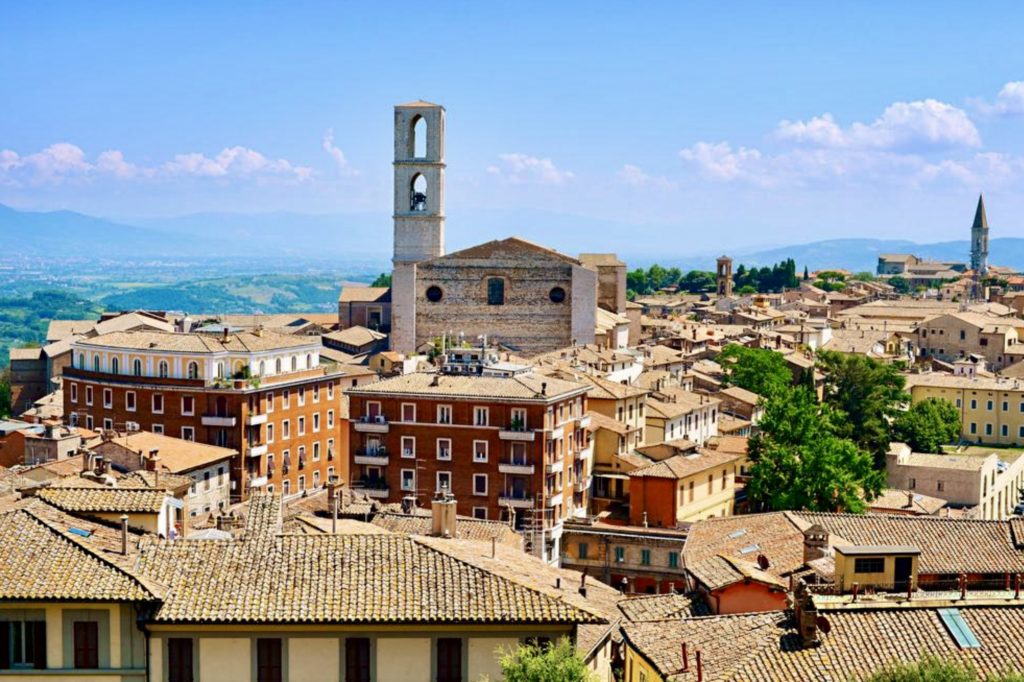
7. Attractions Near Gubbio
Perugia
Perugia is just 40+ minutes from Gubbio. With a pristine medieval center and a lively student population, Perugia is Umbria’s largest and most cosmopolitan city. Its historic center has changed little in more than 400 years.
The city is a helter-skelter of cobbled alleys, arched stairways, and piazzas. The pretty architecture includes fresco filled churches and magnificent Gothic palaces.
The Piazza IV Novembre is a gorgeous medieval square, complete with the Gothic Palazzo dei Priori and an ancient fountain.
Assisi
Assisi is a beautiful UNESCO-listed town perched on Mount Subasio, just 45 from Gubbio.
Assisi is home to Roman ruins, frescoed churches, sun-bleached piazzas, and a craggy lookout fortress. The approach to the town is pure magic.
Assisi has a perfectly preserved medieval quarter where bougainvillea vines tumble over limestone. It’s famous for its gorgeous frescos from the early Renaissance and historic monuments.
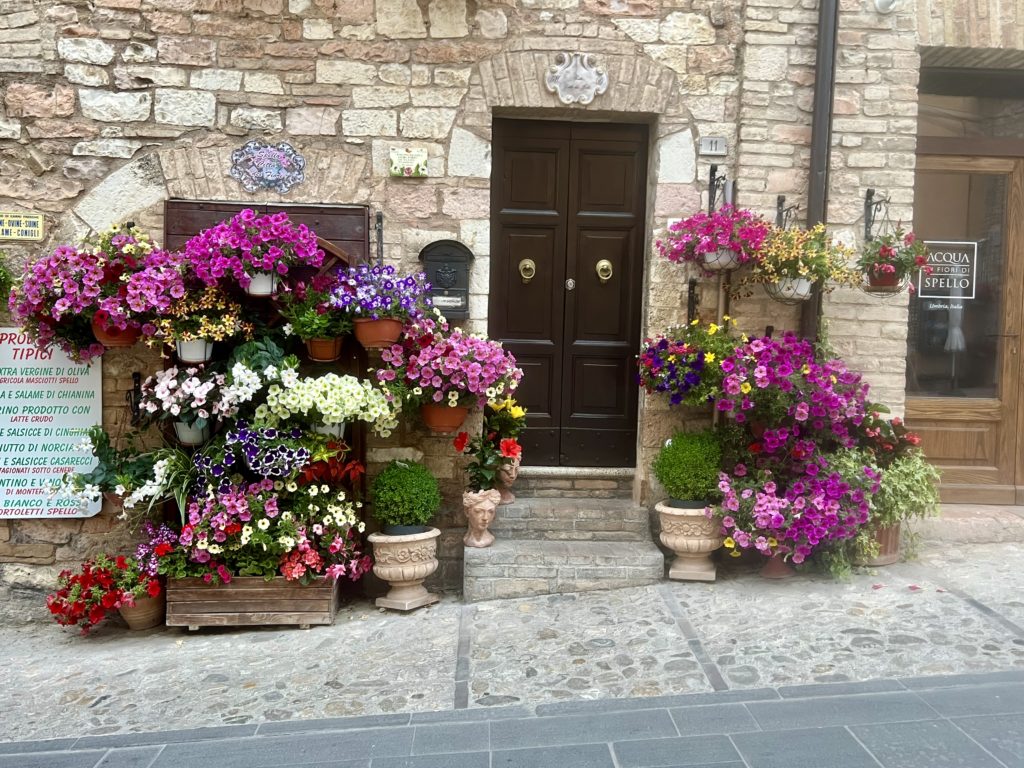
Spello
Spello is a stunning village with cobbled streets and flowers galore, about 45 minutes from Gubbio. It holds the official designation of one of Italy’s most beautiful villages.
Every street in Spello is a postcard perfect feast for the senses. The town seduces with winding medieval streets, crumbly old churches, and Roman ruins.
You’ll be dazzled by rose-colored stone walls, bright terracotta roof tiles, stone pathways, and weathered wooden doors.
I hope you’ve enjoyed my guide to the best things to do in Gubbio. You may enjoy these other Italy travel guides:
- 5 day itinerary for Rome
- Hidden gems in Rome
- 1 day itinerary for Vatican City
- 3 day itinerary for Florence
- 2 day itinerary for Venice
- 1 day itinerary for Milan
- 1 day itinerary for Siena
- Things To Do In San Gimignano
- 10 day itinerary for Tuscany
- 10 day itinerary for Italy’s classic cites
- 11 ways to spend 1 week in Italy
- 30 beautiful towns in Italy
Pin it for later.

